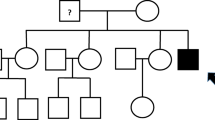Summary
The Alport Syndrome, or hereditary nephropathy with deafness, is inherited as an autosomal dominant trait. Nevertheless, the existence of abnormal distributions of the affected individuals (excess of affected subjects in the offspring of affected females, excess of affected females and deficiency of affected males in the offspring of affected males) has been emphasized by some authors. To explain such an anomaly, these authors suggest the possibility of an abnormal segregation of the dominant gene during the meiosis. 10 families have been studied. These families have been selected because 2 individuals were affected by a hematuric nephropathy, deafness being present in at least one of them. The statistical analysis of these families, taking in account the existence of at least two probands has not shown any abnormal segregation. This disagreement with the facts reported by many authors can be explained either by a statistical bias in the families studied by these authors, or by the relatively little number of families in our study.
Résumé
Le syndrome d'Alport ou néphropathie héréditaire avec surdité se transmet selon le mode dominant autosomique. Cependant, pour expliquer l'existence de répartitions anormales des sujets atteints (excés de malades dans la descendance de femmes atteintes, excès en filles et déficit en fils malades dans la descendance des hommes atteints), différents auteurs ont émis l'hypothèse d'une ségrégation anormale du gène délétère au cours de la méiose chez la femme ou chez l'homme. Notre étude porte sur 10 familles sélectionnées parce qu'elles présentaient au moins 2 sujets atteints de néphropathie hématurique évolutive, avec surdité chez au moins l'un d'entre eux. L'analyse de ces familles, tenant compte de la présence d'au moins deux proposants par famille, ne montre pas de ségrégation anormale. Cette discordance avec les faits rapportés par différents auteurs peut s'expliquer, soit par un biais dans le recrutement des familles analysées dans la littérature, soit par le nombre relativement restreint des familles que nous avons étudiées.
Zusammenfassung
Das Alport-Syndrom, eine erbliche Nephropathie mit Taubheit, wird autosomal dominant vererbt. Die Beobachtung einer abnormen Verteilung der Erkrankten innerhalb der Familien (Überschuß an Kranken in der Nachkommenschaft kranker Frauen, Überschuß kranker Mädchen und Defizit an kranken Jungen in der Nachkommenschaft kranker Männer) veranlaßte verschiedene Autoren zu der Hypothese einer abnormen Segregation des betreffenden Genes während der Meiose der Frau oder des Mannes. Unsere Untersuchung basiert auf 10 ausgesuchten Familien. In jeder Familie zeigten wenigstens zwei Mitglieder eine Nephropathie mit Hämaturie, während die Taubheit wenigstens bei einem der beiden gesichert war. Die Analyse dieser Familien unter Berücksichtigung der Tatsache, daß jede Familie wenigstens zwei Erkrankte aufwies, zeigt keine abnorme Segregation. Dieser Widerspruch zu den Ergebnissen verschiedener Autoren kann eine Folge ungenügender Auswahlkriterien der untersuchten Familien in der Literatur sein oder auf der relativ kleinen Zahl der von uns untersuchten Familien beruhen.
Similar content being viewed by others
Bibliographie
Alport, A. C.: Hereditary familial congenital haemorrhagic nephritis. Brit. med. J. 1927 I, 504–506.
Cohen, M. M., Cassady, G., Hanna, B. L.: A genetic study of hereditary renal dysfunction with associated nerve deafness. Amer. J. hum. Genet. 13, 379–389 (1961).
Delepierre, M. M.: Syndrome d'Alport et néphropathie hématurique sans surdité. Revue de la littérature. Thèse Paris 1969.
Graham, J. B.: Hereditary chronic Kidney disease: An alternative to partial sex-linkage in the Utah Kindred. Amer. J. hum. Genet. 11, 333–338 (1959).
Guthrie, L. C.: “Idiopathic” or congenital hereditary and family hematuria. Lancet 1902 I, 1243–1246.
Junod, J. P.: La néphropathie héréditaire avec surdité et atteinte oculaire. Actualités Néphrologiques de l'hôpital Necker. Paris: Flammarion 1963.
Marie, J., Royer, P., Habib, R., Mathieu, K., Reveillaud, R. J.: La néphropathie hématurique héréditaire avec surdité. Sem. Hôp. Paris 36, 84–103 (1960).
Morton, N. E.: Further scoring types in sequential linkage tests with a critical review of autosomal and partial sex-linkage in man. Amer. J. hum. Genet. 9, 55–75 (1957).
Mulrow, P. J., Aron, A. M., Gathman, G. E., Yesner, R., Lubs, H. A.: Hereditary nephritis. Reports of a Kindred. Amer. J. Med. 35, 737 (1963).
Perkoff, G. T., Stephens, F. E., Dolowitz, D. A., Tyler, F. K.: A clinical study of hereditary interstitial pyelonephritis. Arch. intern. Med. 88, 191–200 (1951).
—, Nugent, C. A., Dolowitz, D. A., Stephens, F. E., Carnes, W. K., Tyler, F. K.: A follow-up study of hereditary chronic nephritis. Arch. intern. Med. 102, 733–746 (1958).
Royer, P., Frezal, J., Bois, E., Feingold, J.: Les néphropathies héréditaires. Arch. franç. Pédiat. 27, 293–317 (1970).
Shaw, R. F., Glover, R. A.: Abnormal segregation in hereditary renal disease with deafness. Amer. J. hum. Genet. 13, 89–97 (1961).
Author information
Authors and Affiliations
Rights and permissions
About this article
Cite this article
Feingold, J., Bois, E. Génétique du syndrome d'Alport. Hum Genet 12, 29–34 (1971). https://doi.org/10.1007/BF00291029
Received:
Issue Date:
DOI: https://doi.org/10.1007/BF00291029




